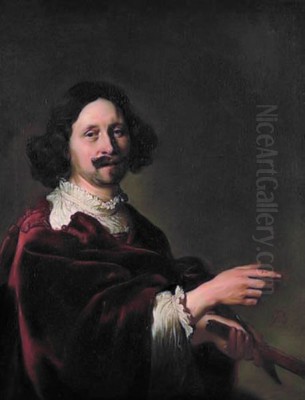
Bartholomeus Breenbergh stands as a significant, though sometimes overlooked, figure in the constellation of artists defining the Dutch Golden Age. Active during a period dominated by masters like Rembrandt van Rijn and Frans Hals, Breenbergh carved a distinct niche for himself, becoming one of the foremost pioneers of the Italianate landscape style among Dutch painters. His work, characterized by meticulous detail, luminous depictions of Mediterranean light, and a deep engagement with classical antiquity and biblical narratives, offers a fascinating bridge between Northern European sensibilities and the allure of the South. Though perhaps less famous than some contemporaries, his artistic journey, particularly his formative years in Rome, and his subsequent influence, mark him as a crucial contributor to seventeenth-century European art.
Early Life and Artistic Formation in the Netherlands
Bartholomeus Breenbergh was born in the Dutch town of Deventer, likely around 1598. His family background was respectable; his father was an apothecary, suggesting a middle-class upbringing. Tragedy struck early, however, with the death of his father in 1607. Following this loss, the Breenbergh family, including his mother Anna Bueck, relocated to Hoorn. Details about Breenbergh's earliest artistic training remain somewhat obscure. While some accounts suggest initial instruction in Hoorn, concrete evidence is lacking. It is more certain that his formative artistic experiences took place in Amsterdam, where the family appears to have moved later.
By 1619, Breenbergh is officially documented as a painter in Amsterdam. This registration implies that he had already achieved a degree of competence and professional standing. During this period in Amsterdam, the artistic scene was vibrant, heavily influenced by the generation of painters often referred to as the "Pre-Rembrandtists." These artists, including figures like Pieter Lastman and Jacob Pynas, specialized in history painting, often drawing subjects from the Bible and classical mythology, set within elaborate landscapes or architectural settings. Breenbergh's early work shows clear affinities with this style, suggesting he likely received training or was significantly influenced by one or more painters within this circle. Lastman, in particular, who would later famously teach Rembrandt, seems a probable influence, given the narrative focus and compositional structures seen in Breenbergh's initial output.
The Roman Sojourn: A Defining Period
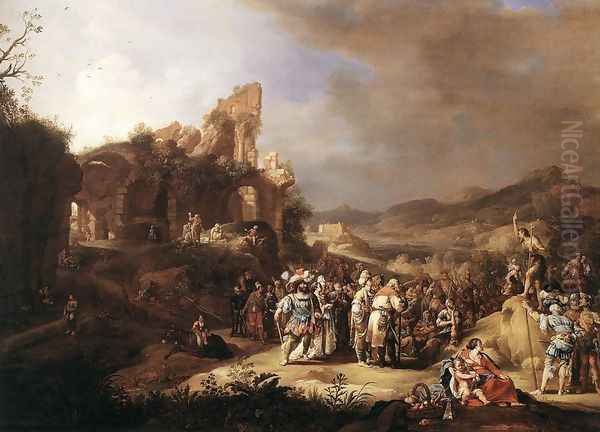
Like many ambitious Northern European artists of his generation, Breenbergh felt the powerful pull of Italy, the cradle of classical antiquity and the Renaissance. Around 1619 or 1620, he embarked on the journey south, settling in Rome. This decade spent in Italy would prove absolutely pivotal, shaping his artistic vision and defining the trajectory of his career. Rome, at this time, was a bustling international hub for artists, drawn to its ancient ruins, its High Renaissance and Baroque masterpieces, and the patronage opportunities offered by the Church and wealthy families.
In Rome, Breenbergh quickly integrated into the community of Netherlandish artists. He is known to have lived and worked closely with the Flemish painter Frans van de Casteele (also known as Francesco da Castello). More significantly, he developed a close association with the established Flemish landscape painter Paul Bril. Bril, who had been working successfully in Rome for decades, was a master of the late Mannerist landscape style, often incorporating mythological or biblical scenes into idealized natural settings. Breenbergh studied Bril's work intently, even copying some of his paintings, absorbing his techniques for rendering foliage, atmospheric perspective, and the integration of figures into landscapes.
Another crucial influence during Breenbergh's Roman period was his Dutch contemporary, Cornelis van Poelenburch. Poelenburch had arrived in Rome slightly earlier and was already developing a distinctive style of small-scale Italianate landscapes, often featuring smooth, enamel-like finishes, idyllic pastoral scenes, and mythological figures bathing or resting amidst classical ruins. Breenbergh and Poelenburch became leading figures among the first generation of Dutch painters specializing in these Italianate scenes. Their styles were often closely related, focusing on the warm light of the Campagna, the picturesque quality of ancient ruins, and an overall Arcadian mood, though Breenbergh's touch was perhaps often slightly crisper and his compositions sometimes more dramatic than Poelenburch's.
Breenbergh was also a founding member of the "Bentvueghels" (Dutch for "Birds of a Feather"), a society primarily composed of Dutch and Flemish artists working in Rome. Known for their bohemian rituals and initiation ceremonies (often involving mock baptisms and the adoption of humorous nicknames – Breenbergh's was "Het Fret," or "The Ferret"), the Bentvueghels provided a crucial social and professional network. Beyond the revelry, the group fostered artistic exchange and mutual support among expatriate artists navigating the competitive Roman art world. Other members included painters like Herman van Swanevelt, who also specialized in Italianate landscapes.
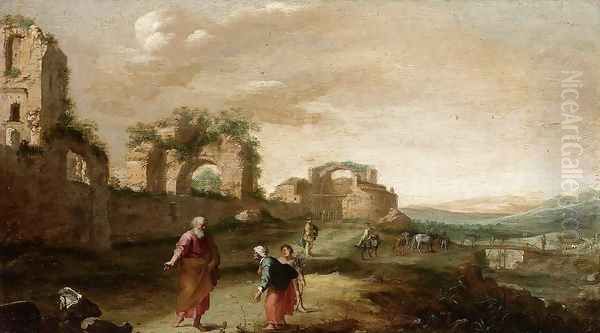
During his time in Italy, Breenbergh was incredibly productive, not only painting but also creating numerous drawings. He sketched prolifically en plein air (outdoors), capturing the specific details of Roman monuments like the Colosseum, the Baths of Caracalla, the ruins on the Palatine Hill, and the landscapes around Tivoli. These detailed drawings, rendered with precision and a keen eye for architectural structure and the effects of light, served as invaluable source material for his paintings long after he left Italy. They demonstrate his profound engagement with the physical remnants of the classical world and the unique atmosphere of the Italian countryside.
Artistic Style: Precision, Light, and Narrative
Bartholomeus Breenbergh's mature artistic style, forged during his Roman years and refined upon his return to the Netherlands, is marked by several key characteristics. Central to his appeal is his masterful handling of light. He excelled at capturing the warm, golden glow of the Italian sun, often using strong contrasts between brightly lit areas and deep shadows (chiaroscuro) to create dramatic effect and model form, particularly in his depictions of crumbling architecture. This sensitivity to light imbues his landscapes with a palpable sense of place and atmosphere, transporting the viewer to the sun-drenched environs of the Roman Campagna.
Precision and meticulous detail are hallmarks of his technique. Unlike the broader, more painterly approach of some contemporaries, Breenbergh typically employed fine, controlled brushwork. This allowed him to render architectural details, foliage, and the textures of stone and earth with remarkable clarity. His figures, though often small in scale relative to the expansive landscapes, are usually carefully delineated. This precision lends his works a jewel-like quality, inviting close inspection. While some sources mention pointillist techniques, it's perhaps more accurate to describe his method as involving careful, distinct touches of paint to build up form and texture, rather than true Pointillism in the 19th-century sense.
Compositionally, Breenbergh often favored views framed by imposing architectural elements – towering ruins, classical archways, or rocky outcrops – which lead the viewer's eye into the receding landscape beyond. He skillfully integrated narrative elements, typically drawn from the Bible or Ovid's Metamorphoses, into these settings. The figures enacting these stories are often dwarfed by their surroundings, emphasizing the grandeur of nature and the passage of time embodied by the ancient ruins. This juxtaposition of the ephemeral human drama against the enduring backdrop of landscape and history is a recurring theme in his work.
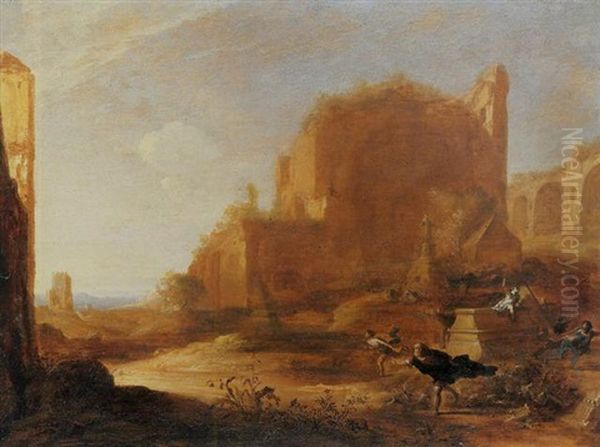
His style remained closely related to that of Cornelis van Poelenburch, particularly in their shared subject matter and idealized vision of Italy. Distinguishing between their unsigned works can sometimes be challenging for art historians. However, Breenbergh's work occasionally displays a greater sense of monumentality or dramatic tension compared to Poelenburch's often more serene and pastoral scenes. He also tended to avoid the extreme, almost porcelain-like smoothness found in some of Poelenburch's paintings, retaining a slightly more visible brushstroke and textural variation.
Return to Amsterdam and Stylistic Evolution
Around 1633, after roughly a decade in Italy, Breenbergh returned to the Netherlands and settled permanently in Amsterdam. He married Rebecca Schellingwou in 1633 and seems to have established a successful career. While he continued to draw upon his Italian experiences and sketches for inspiration, his artistic focus underwent a noticeable evolution during this later phase of his career.
He continued to paint Italianate landscapes, which remained popular with Dutch collectors seeking souvenirs of the Grand Tour or simply captivated by the romance of Italy. However, he increasingly turned his attention towards larger, more complex compositions with a stronger emphasis on historical and biblical narratives. This shift aligns him more closely with Amsterdam history painters like his former influence Pieter Lastman, as well as Nicolaes Moeyaert. These later works often feature larger, more prominent figures and more elaborate storytelling, set within architectural or landscape settings that still betray his Italian experiences but are sometimes imbued with a slightly cooler, Northern light.
Works from this period, such as Joseph Distributing Corn in Egypt (1655) or The Sacrifice of Paul and Barnabas at Lystra (1637), showcase this development. The landscape, while still important, often serves more explicitly as a stage for the human drama unfolding within it. His handling of figures also shows development, displaying a greater confidence in rendering anatomy and expressive gestures. Some art historians note an innovative quality in his depiction of figures and statuary during this later period. Alongside his painting activities, Breenbergh also appears to have engaged in some business dealings, reflecting the often multifaceted careers of artists in the Dutch Republic. He remained an active artist until his death in Amsterdam in October 1657.
Key Works and Themes
Breenbergh's oeuvre encompasses a range of subjects, but certain themes and specific works stand out as representative of his artistic achievements. His Italianate landscapes populated with mythological or biblical figures are perhaps his most characteristic creations.
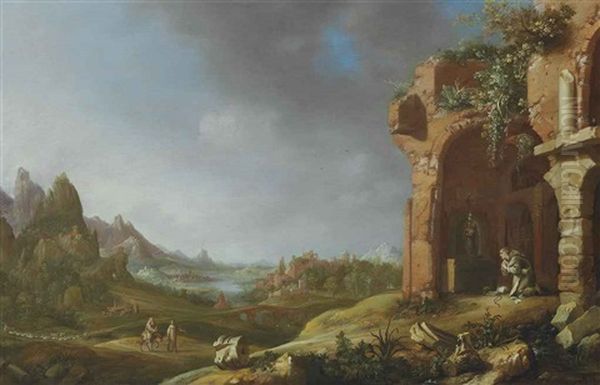
Italian Landscapes with Ruins: Many of his most celebrated works fall into this category. Paintings like Italian Landscape with the Aurelian Wall (Mauritshuis, The Hague) exemplify his ability to combine topographical accuracy (depicting identifiable Roman structures) with an idealized, picturesque sensibility. These works capture the romantic decay of antiquity bathed in warm Mediterranean light.
Biblical Narratives: Breenbergh frequently depicted scenes from the Old and New Testaments. The Preaching of John the Baptist (1634; Metropolitan Museum of Art, New York) is a prime example from his post-Italian period. It showcases his ability to manage a large number of figures within a dramatic landscape setting, dominated by imposing ruins that lend historical weight to the scene. Other notable biblical works include Moses and Aaron Changing the Rivers of Egypt to Blood (1631), The Discovery of Moses by the Daughters of Pharaoh (1630s), Elijah and the Widow of Zarephath, and the late work Joseph Distributing Corn in Egypt (1655). These paintings demonstrate his skill in visual storytelling, integrating the narrative seamlessly with the atmospheric landscape. The Sacrifice of Paul and Barnabas at Lystra (1637) is another significant example of his history painting. The Resurrection (Art Institute of Chicago) tackles a core Christian theme.
Mythological Scenes: Classical mythology provided another rich source of inspiration, allowing Breenbergh to explore Arcadian themes and depict the nude figure within idyllic landscapes. Landscape with Apollo and Daphne (1640) and Venus Mourning the Death of Adonis (1646; Harvard Art Museums) are fine examples. These works often share the same luminous atmosphere and detailed rendering of landscape and ruins found in his other paintings, populated by figures from Ovidian tales.
Throughout these various themes, Breenbergh consistently demonstrated his fascination with the interplay between nature, history, and human drama. His works offered Dutch audiences an evocative glimpse into the classical and biblical past, filtered through the lens of the Italian landscape.
Breenbergh and his Contemporaries
Situating Breenbergh within the bustling art world of the Dutch Golden Age requires considering his relationships – direct and indirect – with other major artists. While he operated in the same city, Amsterdam, as Rembrandt for a significant portion of his career (from the 1630s onwards), there is no documented evidence of direct collaboration, close friendship, or specific correspondence between the two. Their artistic paths, while both rooted in the Dutch tradition, diverged significantly. Rembrandt focused increasingly on portraiture, psychological depth, and a highly personal, expressive handling of paint, while Breenbergh remained dedicated to his more polished, Italianate style.
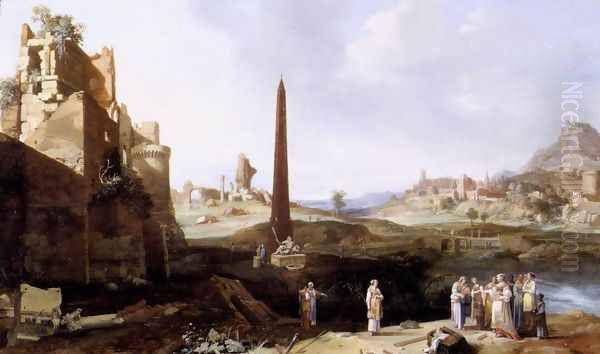
However, they shared certain formative influences. Both artists were impacted by the Pre-Rembrandtists, particularly Pieter Lastman. This shared background might suggest a mutual awareness, even if their mature styles differed greatly. Rembrandt's rising fame in Amsterdam, particularly after receiving a prestigious commission indirectly linked to the English court around 1633, certainly contributed to the city's dynamic artistic climate in which Breenbergh also operated.
Similarly, direct records linking Breenbergh to the Haarlem-based portrait master Frans Hals are lacking. While both were giants of the Golden Age, their specialties and geographical bases (though Amsterdam and Haarlem are close) likely meant their professional circles did not significantly overlap. Hals's focus on capturing the immediacy of personality through vigorous brushwork contrasts sharply with Breenbergh's detailed, landscape-centric approach.
Breenbergh's most significant artistic connections were with fellow Italianate painters. His relationship with Cornelis van Poelenburch in Rome was foundational. He also clearly learned from Paul Bril. Upon returning to Amsterdam, he was part of a milieu that included Nicolaes Moeyaert. He belonged to the first wave of Dutch artists who traveled to Italy and specialized in depicting its landscapes, a group sometimes called the "Dutch Italianates." This group also included artists like Herman van Swanevelt (fellow Bentvueghel member) and later, more famously, painters such as Jan Both, Nicolaes Berchem, and Karel Dujardin, who built upon the foundations laid by Breenbergh and Poelenburch.
Crucially, Breenbergh's work had an impact beyond the Netherlands. His idealized yet carefully observed depictions of the Italian landscape, particularly his handling of light and atmosphere, are considered an important influence on the French master Claude Lorrain. Claude, who spent most of his career in Rome, perfected the ideal landscape, and Breenbergh's pioneering work in this genre undoubtedly contributed to the artistic environment from which Claude's own style emerged.
Legacy and Influence
Bartholomeus Breenbergh's legacy lies primarily in his role as a key founder and exponent of the Dutch Italianate landscape tradition. Alongside Cornelis van Poelenburch, he established a highly popular genre that captivated Dutch audiences with its depictions of a sunlit, classical world, far removed from the often grey skies of the Netherlands. His paintings offered a form of escapism, an imaginative journey to the historical and mythological heartland of European culture.
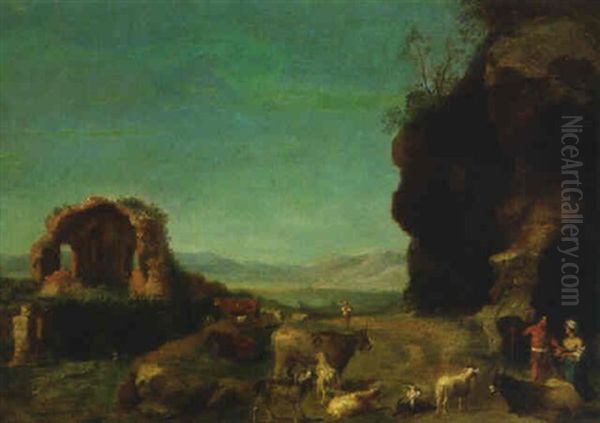
His technical proficiency – the meticulous detail, the skillful rendering of light and shadow, the harmonious integration of figures and landscape – set a high standard. His numerous drawings, particularly those made in Rome, remain valuable documents not only of his working process but also of the appearance of Roman ruins in the early seventeenth century.
While his name might not possess the immediate recognition of Rembrandt or Vermeer today, his influence was significant. His impact on Claude Lorrain is a testament to the quality and originality of his vision. He helped shape the course of European landscape painting, demonstrating how the specific scenery of Italy could be transformed into idealized, poetic visions. His works continue to be held in major museum collections worldwide, including the Metropolitan Museum of Art in New York, the Mauritshuis in The Hague, the Harvard Art Museums, and the Art Institute of Chicago, allowing contemporary audiences to appreciate his unique contribution.
However, his legacy is not without complexities. The close stylistic relationship with Poelenburch has sometimes led to attribution difficulties, requiring careful connoisseurship to distinguish their hands. Furthermore, as noted in some sources, while appreciated, his specific style perhaps found less resonance within the mainstream of later Dutch landscape painting (which increasingly focused on native scenery) compared to its impact on artists working in or influenced by Italy, like Claude or later Italianates.
Conclusion
Bartholomeus Breenbergh occupies a vital position in the rich tapestry of Dutch Golden Age art. He was an artist who successfully synthesized his Northern European training with the profound impact of the Italian landscape and classical antiquity. His Roman sojourn transformed his art, leading him to pioneer a style of Italianate landscape painting characterized by luminous light, meticulous detail, and the evocative integration of narrative elements. While perhaps overshadowed in popular consciousness by artists with different specializations, Breenbergh's work was influential, particularly on the development of ideal landscape painting in Europe. His paintings and drawings remain captivating portals into an idealized vision of Italy, rendered with exceptional skill and sensitivity, securing his place as a master of the Dutch Italianate school.